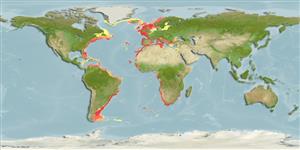Classification / Names
Common names from other countries
Main reference
Size / Weight / Age
Max length : 210 cm TL male/unsexed; (Ref. 7251); common length : 80.0 cm TL male/unsexed; (Ref. 3397); max. published weight: 100.0 kg (Ref. 35388)
Length at first maturity
Lm 77.9 range ? - 90 cm
Environment
Marine; demersal; oceanodromous (Ref. 51243); depth range 40 - 600 m (Ref. 7251), usually 100 - 200 m (Ref. 36731)
Climate / Range
Deep-water, preferred 17°C (Ref. 107945); 70°N - 55°S, 82°W - 179°E
Distribution
Eastern Atlantic: Norway to South Africa (Ref. 6633), including the Mediterranean, Canary Islands, Madeira, Cape Verde, and Tristan da Cunha. Western Atlantic: Newfoundland, Canada and Gulf of Maine to North Carolina, USA (Ref. 7251). Recorded from Uruguay to Argentina (Ref. 9050). Western Indian Ocean: St. Paul and Amsterdam islands (Ref. 6633). Southwest Pacific: New Zealand (Ref. 5755, 9072).
Countries | FAO areas | Ecosystems | Occurrences | Introductions
Short description
Dorsal
spines
(total): 10 - 12;
Dorsal
soft rays
(total): 11-13;
Anal
spines: 3;
Anal
soft rays: 8 - 10. Bluish grey above, paler below with a silvery sheen; fins blackish brown (Ref. 6633). Juveniles have black blotches on head and body (Ref. 6633). Body tall, compressed. Big mouth with big head and a rough bony ridge across upper part of the gill cover (Ref. 35388).
IUCN Red List Status (Ref. 115185)
Threat to humans
Harmless
Human uses
Fisheries: minor commercial; gamefish: yes
More information
ReferencesAquacultureAquaculture profileStrainsGeneticsAllele frequenciesHeritabilityDiseasesProcessingMass conversion
Tools
Can't connect to MySQL database fbquizv2. Errorcode: Too many connections
